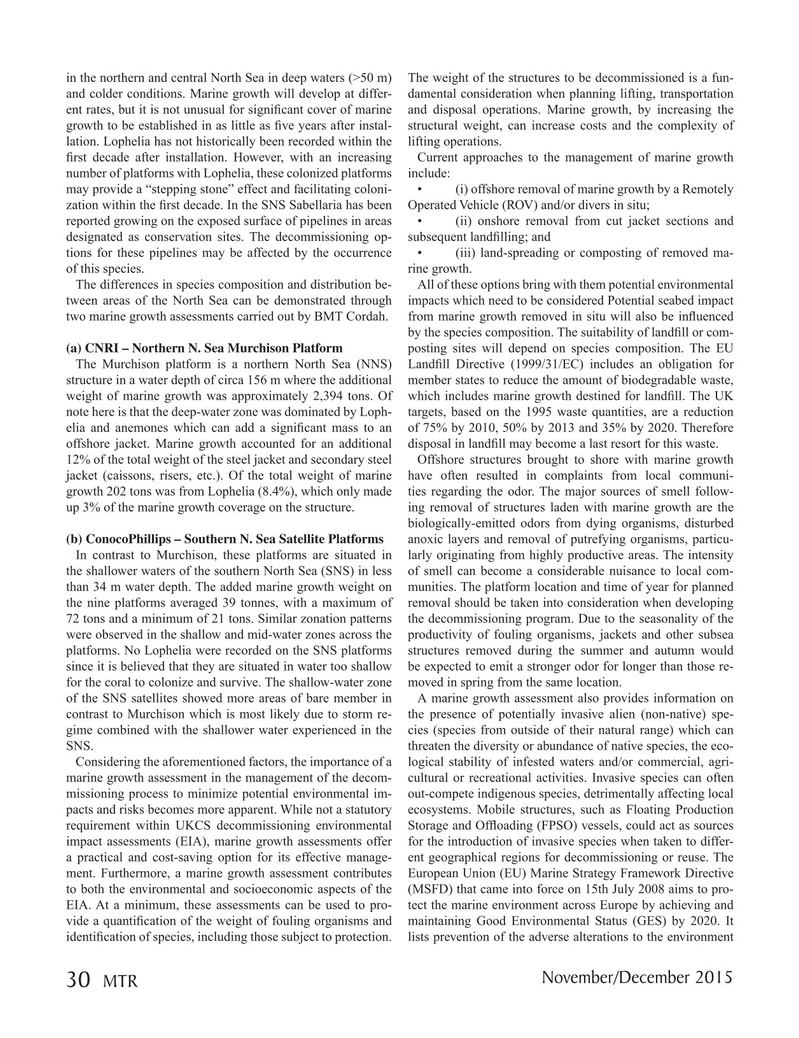
Page 30: of Marine Technology Magazine (November 2015)
Read this page in Pdf, Flash or Html5 edition of November 2015 Marine Technology Magazine
in the northern and central North Sea in deep waters (>50 m) The weight of the structures to be decommissioned is a fun- and colder conditions. Marine growth will develop at differ- damental consideration when planning lifting, transportation ent rates, but it is not unusual for signi? cant cover of marine and disposal operations. Marine growth, by increasing the growth to be established in as little as ? ve years after instal- structural weight, can increase costs and the complexity of lation. Lophelia has not historically been recorded within the lifting operations. ? rst decade after installation. However, with an increasing Current approaches to the management of marine growth number of platforms with Lophelia, these colonized platforms include: may provide a “stepping stone” effect and facilitating coloni- • (i) offshore removal of marine growth by a Remotely zation within the ? rst decade. In the SNS Sabellaria has been Operated Vehicle (ROV) and/or divers in situ; reported growing on the exposed surface of pipelines in areas • (ii) onshore removal from cut jacket sections and designated as conservation sites. The decommissioning op- subsequent land? lling; and tions for these pipelines may be affected by the occurrence • (iii) land-spreading or composting of removed ma- of this species. rine growth.
The differences in species composition and distribution be- All of these options bring with them potential environmental tween areas of the North Sea can be demonstrated through impacts which need to be considered Potential seabed impact two marine growth assessments carried out by BMT Cordah. from marine growth removed in situ will also be in? uenced by the species composition. The suitability of land? ll or com- (a) CNRI – Northern N. Sea Murchison Platform posting sites will depend on species composition. The EU
The Murchison platform is a northern North Sea (NNS) Land? ll Directive (1999/31/EC) includes an obligation for structure in a water depth of circa 156 m where the additional member states to reduce the amount of biodegradable waste, weight of marine growth was approximately 2,394 tons. Of which includes marine growth destined for land? ll. The UK note here is that the deep-water zone was dominated by Loph- targets, based on the 1995 waste quantities, are a reduction elia and anemones which can add a signi? cant mass to an of 75% by 2010, 50% by 2013 and 35% by 2020. Therefore offshore jacket. Marine growth accounted for an additional disposal in land? ll may become a last resort for this waste. 12% of the total weight of the steel jacket and secondary steel Offshore structures brought to shore with marine growth jacket (caissons, risers, etc.). Of the total weight of marine have often resulted in complaints from local communi- growth 202 tons was from Lophelia (8.4%), which only made ties regarding the odor. The major sources of smell follow- up 3% of the marine growth coverage on the structure. ing removal of structures laden with marine growth are the biologically-emitted odors from dying organisms, disturbed (b) ConocoPhillips – Southern N. Sea Satellite Platforms anoxic layers and removal of putrefying organisms, particu-
In contrast to Murchison, these platforms are situated in larly originating from highly productive areas. The intensity the shallower waters of the southern North Sea (SNS) in less of smell can become a considerable nuisance to local com- than 34 m water depth. The added marine growth weight on munities. The platform location and time of year for planned the nine platforms averaged 39 tonnes, with a maximum of removal should be taken into consideration when developing 72 tons and a minimum of 21 tons. Similar zonation patterns the decommissioning program. Due to the seasonality of the were observed in the shallow and mid-water zones across the productivity of fouling organisms, jackets and other subsea platforms. No Lophelia were recorded on the SNS platforms structures removed during the summer and autumn would since it is believed that they are situated in water too shallow be expected to emit a stronger odor for longer than those re- for the coral to colonize and survive. The shallow-water zone moved in spring from the same location. of the SNS satellites showed more areas of bare member in A marine growth assessment also provides information on contrast to Murchison which is most likely due to storm re- the presence of potentially invasive alien (non-native) spe- gime combined with the shallower water experienced in the cies (species from outside of their natural range) which can
SNS. threaten the diversity or abundance of native species, the eco-
Considering the aforementioned factors, the importance of a logical stability of infested waters and/or commercial, agri- marine growth assessment in the management of the decom- cultural or recreational activities. Invasive species can often missioning process to minimize potential environmental im- out-compete indigenous species, detrimentally affecting local pacts and risks becomes more apparent. While not a statutory ecosystems. Mobile structures, such as Floating Production requirement within UKCS decommissioning environmental Storage and Of? oading (FPSO) vessels, could act as sources impact assessments (EIA), marine growth assessments offer for the introduction of invasive species when taken to differ- a practical and cost-saving option for its effective manage- ent geographical regions for decommissioning or reuse. The ment. Furthermore, a marine growth assessment contributes European Union (EU) Marine Strategy Framework Directive to both the environmental and socioeconomic aspects of the (MSFD) that came into force on 15th July 2008 aims to pro-
EIA. At a minimum, these assessments can be used to pro- tect the marine environment across Europe by achieving and vide a quanti? cation of the weight of fouling organisms and maintaining Good Environmental Status (GES) by 2020. It identi? cation of species, including those subject to protection. lists prevention of the adverse alterations to the environment
November/December 2015 30 MTR
MTR #9 (18-33).indd 30 12/8/2015 10:33:51 AM

 29
29

 31
31
